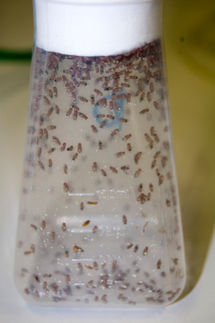Fern's evolution gives arsenic tolerance that may clean toxic land
Advertisement
Isolating a gene that allows a type of fern to tolerate high levels of arsenic, Purdue University researchers hope to use the finding to create plants that can clean up soils and waters contaminated by the toxic metal. The fern Pteris vittata can tolerate 100 to 1,000 times more arsenic than other plants. Jody Banks, a professor of botany and plant pathology, and David Salt, a professor of horticulture, uncovered what may have been an evolutionary genetic event that creates an arsenic pump of sorts in the fern.
"It actually sucks the arsenic out of the soil and puts it in the fronds," Banks said. "It's the only multi-cellular organism that can do this."
Without a genome sequenced for Pteris vittata , Banks and Salt used a method of gene identification called yeast functional complementation. They combined thousands of different Pteris vittata genes into thousands of yeast cells that were missing a gene that makes them tolerant to arsenic. The yeast was exposed to arsenic, with most of it dying. The yeast strains that lived had picked up the genes from Pteris vittata that convey arsenic resistance. To confirm that this was the correct gene, its function was knocked down and the plant was exposed to arsenic. Without the gene functioning properly, the plant could not tolerate arsenic.
"It tells us that this gene is necessary for the plant to function on arsenic," said Banks, whose findings were published in the early online version of the journal Plant Cell. "We looked for a similar gene in the plant Arabidopsis. We couldn't find it. It can't be found in any flowering plant."
Banks and Salt found that the protein encoded by this gene ends up in the membrane of the plant cell's vacuole. Salt said the protein acts as a pump, moving arsenic into the cell's equivalent of a trashcan.
"It stores it away from the cytoplasm so that it can't have an effect on the plant," Salt said.
Banks said understanding how the Pteris vittata functions with arsenic could lead to ways to clean up arsenic-contaminated land.
"Potentially you could take these genes and put them in any organism that could suck the arsenic out of the soil," Banks said.
Salt said rice plants could be modified with the gene to store arsenic in the roots of plants - instead of rice grains - in contaminated paddies.


























































